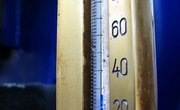
Temperature, relative humidity and dew point are all related to one another. Temperature is the measure of the energy in the air, relative humidity is the measure of water vapor in the air, and the dew point is the temperature at which the water vapor in the air will begin to condense into liquid water (reference 1). Determining the three values starts with some simple temperature measurements. From there, you will need to consult various charts to calculate the relative humidity and dew point.
- Two thermometers
- A small section of paper towel
- Water
Bring your materials outside at the time when you want to determine the temperature, relative humidity and dew point. Let them sit for five minutes so that your water takes on the temperature of the surrounding air.
Dip the small section of paper towel into your water and wring it out so that it is damp but not dripping wet.
Wrap the moist paper towel around the metal bulb of one of the thermometers. This will now be called the wet bulb. The thermometer without the paper towel wrapped around its bulb will be referred to as the dry bulb.
Let the thermometers sit for five minutes to take the temperature of their surroundings. Because the wet bulb is covered by evaporating water, it will read a lower temperature than the dry bulb; the water takes heat with it as it evaporates. The difference between the two bulbs' temperatures will reveal the humidity.
Calculate the Wet Bulb Depression by subtracting the wet bulb temperature reading from the dry bulb temperature reading. For instance, imagine that after five minutes the dry bulb thermometer read 100 degrees Fahrenheit and the wet bulb read 94 degrees Fahrenheit. The calculation would look like this:
Wet Bulb Depression = 100 - 94 = 6
Consult the Relative Humidity Chart through the link in the resources section below to find out the relative humidity indicated by your thermometer readings. In the example, the chart shows that an air temperature of 100 degrees Fahrenheit combined with a Wet Bulb Depression of 6 indicates a relative humidity of 80 percent.
Consult the Dew Point Chart through the second link in the Resources section below to find out the dew point given the air temperature and relative humidity values that you have determined so far. In the example, the chart shows that an air temperature of 100 degrees Fahrenheit combined with a relative humidity of 80 percent indicates a dew point of 93 degrees Fahrenheit.
Things You'll Need
References
About the Author
Timothy Banas has a master's degree in biophysics and was a high school science teacher in Chicago for seven years. He has since been working as a trading systems analyst, standardized test item developer, and freelance writer. As a freelancer, he has written articles on everything from personal finances to computer technology.
Photo Credits
dew image by Filip Pivarci from Fotolia.com
